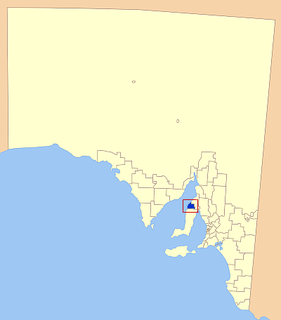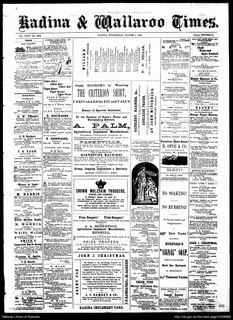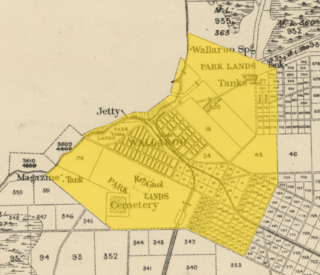The Corporate Town of Moonta was a local government area in South Australia from 1872 to 1984, centred on the town of Moonta. [1] [2]
The Corporate Town of Moonta was a local government area in South Australia from 1872 to 1984, centred on the town of Moonta. [1] [2]
The town was proclaimed on 1 August 1872, following local debate over the merits of local government earlier in the year. [3] [4] [5] [6] It was divided into four wards: North, East, West and South, each electing two councillors. [3] The new council decided not to build their own town hall for financial reasons, but instead decided to collaborate with the trustees of the Moonta Institute in building a replacement institute building on council-owned land. The new building would include a council chamber and corporation offices, a public hall, a reading room and other facilities. [7] [8] The new institute and council chamber was opened by Governor William C. F. Robinson in September 1885. [9]
The corporation instituted its own electric lighting system and plant in 1917, which replaced the previous privately-run gas system. In June 1932, its boundaries were enlarged alongside widespread local government reform that year, and it gained portions of Moonta Bay, North Moonta, Port Hughes and eleven acres of mineral leases to the east of the town from the District Council of Kadina. A fifth ward (Moonta Bay) was added at this time, increasing the total number of councillors to ten. [10] In 1936, it had an area of 323 acres. [1] It ceased to exist on 1 July 1984 when it amalgamated with the District Council of Kadina to form the District Council of Northern Yorke Peninsula. [2]

Wallaroo is a port town on the western side of Yorke Peninsula in South Australia, 160 kilometres (100 mi) northwest of Adelaide. It is one of the three Copper Triangle towns famed for their historic shared copper mining industry, and known together as "Little Cornwall", the other two being Kadina, about 8 kilometres (5 mi) to the east, and Moonta, about 18 kilometres (11 mi) south. In 2015, Wallaroo had an estimated population of 4,010.

Kadina is a town on the Yorke Peninsula of the Australian state of South Australia, approximately 144 kilometres north-northwest of the state capital of Adelaide. The largest town of the Peninsula, Kadina is one of the three Copper Triangle towns famous for their shared copper mining history. The three towns are known as "Little Cornwall" for the significant number of immigrants from Cornwall who worked at the mines in the late 19th century.

Moonta is a town on the Yorke Peninsula of South Australia, 165 km (103 mi) north-northwest of the state capital of Adelaide. It is one of three towns known as the Copper Coast or "Little Cornwall" for their shared copper mining history.

*This article is about a region in Australia. For coast of County Waterford, Ireland, see Copper Coast (Ireland).

The Copper Coast Council is a local government area in the Australian state of South Australia located at the northern end of the Yorke Peninsula. It was established in 1997 and its seat is in Kadina.

Jerusalem is a suburb of the town of Kadina on the Yorke Peninsula. It is located in the Copper Coast Council. The boundaries were formally gazetted in January, 1999, although the name had long been in use for the area.

Wallaroo Mines is a suburb of the inland town of Kadina on the Yorke Peninsula in the Copper Coast Council area.. It was named for the land division in which it was established in 1860, the Hundred of Wallaroo, as was the nearby coastal town of Wallaroo. The boundaries were formally gazetted in January 1999 for "the long established name".

The Kadina and Wallaroo Times was a newspaper published in Kadina, and also serving the nearby Wallaroo, South Australia from August 1888 to August 1966. In 1968 the paper merged to form the Yorke Peninsula Country Times.
Henry Lamshed was a farmer and politician in colonial South Australia.

Cross Roads is a locality at the northern end of the Yorke Peninsula and a satellite village to the town of Moonta on its east. It is located in the Copper Coast Council.

East Moonta is a rural locality at the northern end of the Yorke Peninsula and a satellite village to the town of Moonta. It is located in the Copper Coast Council.

The Balaklava-Moonta railway line was a railway line on the South Australian Railways network. It ran across the top of the Yorke Peninsula.

The District Council of Bute was a local government area in South Australia from 1885 to 1997.

The District Council of Northern Yorke Peninsula was a local government area in South Australia from 1984 to 1997. The council seat was at Kadina.

Boors Plain is a rural locality at the north end of the Yorke Peninsula of South Australia, situated east of Moonta and south of Kadina. It is located in the Copper Coast Council.

The Corporate Town of Wallaroo was a local government area in South Australia from 1874 to 1997, centred on the town of Wallaroo.

The District Council of Kadina was a local government area in South Australia from 1888 to 1984.

The Corporate Town of Kadina was a local government area in South Australia from 1872 to 1977, based in the town of Kadina.
The Yorke Peninsula Country Times is a South Australian newspaper which was first published on 4 September 1968. It was formed following the merging of the Kadina, Wallaroo and Moonta Times and the South Australian Farmer, representing a combined ancestry of 13 former publications, with the earliest dating back to February 1865. It is headquartered in Kadina and its weekly publications are distributed across "the entire peninsula" from Port Broughton in the north to Stenhouse Bay in the south.

The Hundred of Wallaroo is a cadastral unit of hundred located on the Copper Coast of South Australia. It is one of the 16 hundreds of the County of Daly. It was named in 1862 by Governor Dominick Daly after the indigenous term wadla warru presumed to mean wallaby urine.
Coordinates: 34°04′00.3″S137°35′20″E / 34.066750°S 137.58889°E